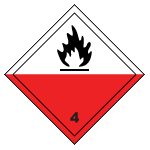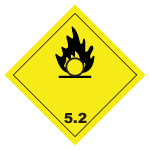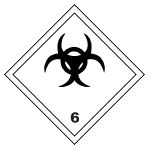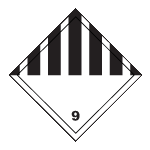危險品分類表
| 危險品分類表 |
Listed on 12-Nov-2007
|
|
Signs
|
Class |
HK CAT
|
Descriptions |
Examples
|
|
1
|
1
|
Explosive substances or articles used to produce explosions | Explosives, munitions, fireworks and flares. | |
|
2.1
|
2
|
Flammable gas |
Gases that can ignite in air on contact with a source of ignition. such as Butane, propane, lighter fuels or refills. |
|
|
2.2
|
2
|
Non-flammable, non-toxic gas |
Gases that are non-flammable, but may cause suffocation. such as Aqualung cylinders, aerosols. |
|
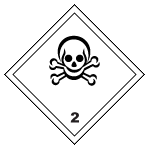 |
2.3
|
2
|
Toxic gas |
Gases likely to cause death or serious injury if inhaled. |
|
3
|
5
|
Flammable liquids |
Liquids, the vapors of which can ignite in air on contact with a source of ignition. such as Paints, thinner, adhesives; |
|
|
4.1
|
8
|
Flammable solids |
Substances that are easily ignited by external sources, such as sparks and flames. such as “strike anywhere matches” and articles which are easily ignited |
|
|
4.2
|
9
|
Substances liable to spontaneous combustion |
Substances likely to heat spontaneously and catch fire. | |
|
4.3
|
6
|
Substances that in contact with water emit flammable gases |
Substances that produce dangerous quantities of flammable gas when in contact with water. Heat from this reaction may cause their gases to spontaneously ignite. | |
|
5.1
|
7
|
Oxidizing substances |
Substances that are not necessarily combustible by themselves, but which produce oxygen, which increases the risk and intensity of fire in other materials with which they may come in contact. such as bleaching powder and peroxides; |
|
|
5.2
|
7
|
Organic peroxides |
Organic substances containing bivalent oxygen that are thermally unstable and likely to react dangerously with other substances. | |
|
6.1
|
4
|
Toxic substances |
Substances likely to cause death or serious injury if swallowed, inhaled or brought into contact with the skin. | |
|
6.2
|
4
|
Infectious substances |
Substances known or likely to contain micro-organisms which can cause disease. | |
|
7
|
– –
|
Radioactive material (CATEGORY I) |
Material for which the specific activity exceeds 70Bq/kg. | |
|
7
|
– –
|
Radioactive material (CATEGORY II or III) |
Material for which the specific activity exceeds 70Bq/kg. | |
|
8
|
3
|
Corrosive substances |
Solid and liquid substances that can severely damage living tissue or attack other materials such as metals. such as Mercury (which may be contained in thermometers or blood pressure gauges), acids, alkalis and wet cell batteries |
|
|
9
|
10
|
Miscellaneous dangerous goods and articles |
Substances and articles that present a danger, but are not covered by other classes. |





